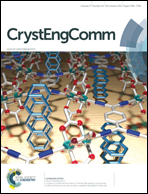Lanthanide diphosphonates based on a V-shaped ligand: syntheses, structures, experimental and theoretical luminescence properties†
Abstract
One series of isostructural lanthanide phosphonates, namely [Ln2(H2L)3][(H2O)5] (H4L = (5-methyl-1,3-phenylene)bis(phosphonic acid); Ln = Eu (1), Gd (2), Tb (3), and Dy (4)), have been successfully synthesized from a V-shaped rigid ligand. Systematic characterizations using single-crystal and powder X-ray diffraction (XRD), thermogravimetric analyses (TGA), and photoluminescence spectroscopy were accomplished. It was found that these compounds all crystallize in the cubic I213 space group, showing three-dimensional framework structures. The frameworks are stable up to 350 °C and show their respective characteristic metal-centered emissions. The photoluminescence properties were also theoretically investigated by using a newly developed software program – LUMPAC. The energy transfer and back energy transfer rates were estimated, and the T1 → 5D1 and T1 → 5D0 channels were revealed to be the dominant pathways. The combination of experimental and theoretical studies on the photoluminescence properties substantially supports the understanding and design of highly luminescent inorganic–organic hybrid materials.


 Please wait while we load your content...
Please wait while we load your content...